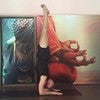Description
About This Video
Transcript
Read Full Transcript
Hello and welcome. In this practice we're going to use the diaphragm, diaphragms of the body, mainly the respiratory diaphragm, to help align the body with clear breath. It's important that you're seated comfortably. I have a tutorial on finding your seat in season 3 of Welcome to Yoga that you could reference, but feel free to sit in a chair, cross-legged. I am most comfortable in Virasana in this kneeling position, so that's how I'm choosing to sit, but definitely find the best seat for you. It's important that you're able to sit with the pelvis upright so that the spine can lift. So the diaphragm muscle, I'm going to use the fingers, kind of find with a muscle. So with your fingers, find your sternum or your breastbone and bring your fingers to the bottom of the breastbone, the xiphoid process. And then with your fingers, just palpate along the bottom of the ribs. And this is where I'm going to dig in a little bit if you're comfortable with that. This is where your diaphragm muscle connects and connects all the way around. The muscle is kind of like an old-fashioned record. It's thin and circular, vinyl. So it connects all the way around there, the base of the ribs and it draws down in the back. But for our purposes, I'm going to think of it being like a record player, a record, connecting to the bottom of the ribs. Rest your hands onto your thighs and close your eyes. And let your breath deepen. And just notice your perception of that diaphragm muscle. Notice how you feel it. It moves. Notice the right side and the left side, the front and the back. And even if you've studied anatomy or you know, and you know about the muscle, see if you can do this exercise with a fresh perspective, as if you just dropped into your body and you're experiencing this breath and this muscle for the first time. Fresh, fresh eyes, you see the experience of the diaphragm inside. And as you're doing this, invite your breath to be long and smooth. Sometimes moving into a long, smooth breath is a process. So if your breath feels short and choppy right now, that's completely fine. You just plant the seed and give the invitation for the breath to lengthen with a smooth quality. So now a little information about the movement of the muscle. When you exhale, it domes upwards. And when you inhale, the muscle flattens and widens. As you exhale, the diaphragm domes up, it pushes into the lungs and the lungs expel the air. As you inhale, the muscle flattens and widens. If your eyes are closed, maybe open them and make the same gesture I'm making with your hands, just interlacing the fingers. And with the hands emulating that movement of the diaphragm, sometimes it's a little, it seems a little different than what it is. So using the hands always helps me to really tap into the movement of the muscle. So exhaling the muscle domes. Inhale, it flattens as the lungs expand. Exhale, you can feel the muscle, the center of the muscles drawing up, making a dome.
Inhale, the muscle flattens, the whole rib cage expands. Exhale, domes. Inhale, flattens and widens. If the hands are helpful, you can keep, keep moving them. Other ways, you can bring your hands down onto your legs. And see if you can keep watching this process of the air coming in, the diaphragm moving down and the lungs expanding and the diaphragm doming up, lungs deflating and the air slides out of the nose. Continuing to invite a long, smooth breath. And now just letting that go for a moment, slide your attention down to the base of the pelvis and just a little bit rock from right to left on your seat and feel the sitting bones rooting and descending. And rock a little bit forward and back on the pelvis. As you roll the pelvis forward, the pubic bone drops. As you roll the pelvis back, the tailbone drops. So you have in your mind's eye now come to neutral the pubic bone in the front, right sitting bone, tail bone in the back, left sitting bone and back to the pubic bone, forming the diamond of the pelvic floor. And then go back to the respiratory diaphragm. Feeling the movement of that diaphragm at the base of the ribs. And also notice the pelvic floor and see if you feel any motion, any movement also in the pelvic floor. For right now not creating anything, just observing to see if there's any awareness of movement there. So whether or not you feel this, there is a movement in the pelvic floor that exactly emulates the movement of the diaphragm. So when you exhale, the pelvic floor muscles lift as the diaphragm domes, two domes in the body. As you inhale, the pelvic floor releases as the diaphragm flattens. And then just exaggerate that a little bit, draw the space of the diamond pelvic floor up as you exhale. And then as you inhale, feel a relaxation, a release, a dilating, widening of the pelvic floor as the respiratory diaphragm is doing the same. The exhalations are the drawing up, tethering up the central piece of the pelvic floor. And as you inhale, there's a release, a widening. And in your mind's eyes, if you can now see these two diaphragms moving together as they're doing, they're already doing it on their own, just tapping into that and you can exaggerate the pelvic floor engagement. If it helps to go back and use the hands, doming on the exhalation, flattening on the inhalation, you can do that. And then adding on the very top of your head, your cranium makes another dome stacked directly above the respiratory diaphragm, stacked directly above the pelvic floor diaphragm. See these three sort of cathedral ceiling or domed ceilings stacked one on top of the other. Continuing to take breath that's relatively even, inhale and exhale. Continuing to invite a smooth quality. And to pull awareness a little bit wider, I like to think of the dome of the atmosphere way above and the sky. Pelvic floor, respiratory diaphragm, the dome at the top of the head and the dome above. This alignment is a nice one to take into any of your other practices. It's also nice to take to your lunch or your meeting or your desk instead of having the diaphragms misaligned to try to keep that feeling of head over diaphragm, over pelvis. So enjoy this journey. Namaste.
Aligned With Breath
Comments


You need to be a subscriber to post a comment.
Please Log In or Create an Account to start your free trial.













